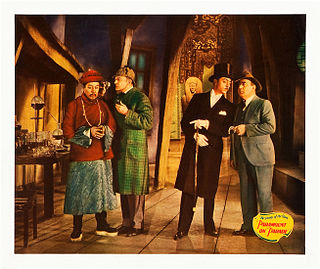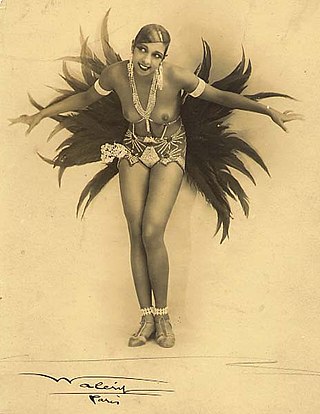Related Research Articles

Maurice Auguste Chevalier was a French singer, actor, and entertainer. He is best known for his signature songs, including "Livin' In The Sunlight", "Valentine", "Louise", "Mimi", and "Thank Heaven for Little Girls", and for his films, including The Love Parade, The Big Pond, The Smiling Lieutenant, One Hour with You, and Love Me Tonight. His trademark attire was a boater hat and tuxedo.

Love Me Tonight is a 1932 American pre-Code musical comedy film produced and directed by Rouben Mamoulian, with music by Rodgers and Hart. It stars Maurice Chevalier as a tailor who poses as a nobleman and Jeanette MacDonald as a princess with whom he falls in love. It also stars Charles Ruggles as a penniless nobleman, along with Charles Butterworth and Myrna Loy as members of his family.

Félix Mayol was a French singer and entertainer.

Jean Sablon was a French singer, songwriter, composer and actor. He was one of the first French singers to immerse himself in jazz. The man behind several songs by big French and American names, he was the first to use a microphone on a French stage in 1936. Star of vinyl records and the radio, he left France in 1937 to take a contract with NBC in the United States. His radio and later televised shows made him a huge star in America. Henceforth the most international of French singers among his contemporaries, he became an ambassador of French songwriting and dedicated his career to touring internationally, occasionally returning to France to appear on stage. His sixty-one year career came to an end in 1984.

The Folies Bergère is a cabaret music hall in Paris, France. Located at 32 Rue Richer in the 9th Arrondissement, the Folies Bergère was built as an opera house by the architect Plumeret. It opened on 2 May 1869 as the Folies Trévise, with light entertainment including operettas, comic opera, popular songs, and gymnastics. It became the Folies Bergère on 13 September 1872, named after nearby Rue Bergère. The house was at the height of its fame and popularity from the 1890s' Belle Époque through the 1920s.

Yvonne Printemps was a French singer and actress who achieved stardom on stage and screen in France and internationally.
"C'est si bon" is a French popular song composed in 1947 by Henri Betti with the lyrics by André Hornez. The English lyrics were written in 1949 by Jerry Seelen. The song has been adapted in several languages.

Albert Willemetz was a French librettist.

Yvonne Vallée was a French actress.
"Thank Heaven for Little Girls" is a 1957 song written by Alan Jay Lerner and Frederick Loewe and associated with Maurice Chevalier, its original performer. It opened and closed the 1958 film Gigi. Alfred Drake performed the song in the 1973 Broadway stage production of Gigi, and in the 2015 revival, it was sung as a duet between Victoria Clark and Dee Hoty.

Margaret Leibovici OBE, known as Miss Bluebell, was an Irish dancer who was the founder of the Bluebell Girls dance troupe.

Paramount on Parade is a 1930 all-star American pre-Code revue released by Paramount Pictures, directed by several directors including Edmund Goulding, Dorothy Arzner, Ernst Lubitsch, Rowland V. Lee, A. Edward Sutherland, Lothar Mendes, Otto Brower, Edwin H. Knopf, Frank Tuttle, and Victor Schertzinger—all supervised by the production supervisor, singer, actress, and songwriter Elsie Janis.

The Casino de Paris, located at 16, rue de Clichy, in the 9th arrondissement, is one of the well known music halls of Paris, with a history dating back to the 18th century. Contrary to what the name might suggest, it is a performance venue, not a gambling house. The closest métro/RER stations are Liège, Trinité–d'Estienne d'Orves, and Haussmann–Saint-Lazare.
Henri Betti, born Ange Betti, was a French composer and a pianist.

Maurice Yvain was a French composer noted for his operettas of the 1920s and 1930s. Some of which were written for Mistinguett, at one time the best-paid female entertainer in the world. In the 1930s and 1940s, he became a major success in the United States and several of his pieces appeared in the famous Ziegfeld Follies on Broadway. He also composed music for several films of notable directors such as Anatole Litvak, Julien Duvivier, and Henri-Georges Clouzot. Yvain's music blended with the then "spirit of Paris".

Folies Bergère de Paris is a 1935 American musical comedy film produced by Darryl Zanuck for 20th Century Films, directed by Roy Del Ruth and starring Maurice Chevalier, Merle Oberon and Ann Sothern. At the 8th Academy Awards, the “Straw Hat” number, choreographed by Dave Gould, won the short-lived Academy Award for Best Dance Direction, sharing the honor with “I've Got a Feelin' You're Foolin'” from Broadway Melody of 1936. The film, based on the 1934 play The Red Cat by Rudolph Lothar and Hans Adler, is a story of mistaken identity, with Maurice Chevalier playing both a music-hall star and a business tycoon who resembles him. This was Chevalier’s last film in Hollywood for twenty years, and reprised familiar themes such as the straw hat and a rendering of the French song "Valentine". This is also the last film to be distributed by Twentieth Century Pictures before it merged with Fox Film in 1935 to form 20th Century Fox.

The Années folles was the decade of the 1920s in France. It was coined to describe the social, artistic, and cultural collaborations of the period. The same period is also referred to as the Roaring Twenties or the Jazz Age in the United States. In Germany, it is sometimes referred to as the Golden Twenties because of the economic boom that followed World War I.
André Hornez was a French lyricist and screenwriter.
"Louise" is a song written by Leo Robin and Richard A. Whiting for the 1929 film Innocents of Paris, where it was performed by Maurice Chevalier. The song was Chevalier's first hit in the United States, and was among the best selling records for 10 weeks in the summer of 1929. Chevalier recorded the song again in 1946 with Henri René's Orchestra for RCA Victor.
Jean-Pierre Coursodon was a French film critic and historian. He wrote film reviews and journal articles to the magazines including Cinéma and Anthologie du Cinéma (1966–1969). In 1967, Coursodon began living in the United States where he contributed essays to Film Comment (1973–1975) and Cinéma d'Aujourd'hui (1975–1976). Since 1988, Coursodon served as an American correspondent for Positif magazine.
References
- 1 2 Michael Freedland (1981). Maurice Chevalier. Morrow. p. 93. ISBN 978-0-688-00652-5. Archived from the original on 2018-02-11.
- ↑ Michael Freedland (1981). Maurice Chevalier. Morrow. p. 93. ISBN 978-0-688-00652-5. Archived from the original on 2018-02-11.
- 1 2 3 4 James Harding (1982-10-01). Maurice Chevalier, his life, 1888–1972 . Secker & Warburg. ISBN 978-0-436-19107-7.
Valentine Maurice Chevalier.
- 1 2 Dave DiMartino (2016-04-15). Music in the 20th Century (3 Vol Set). Routledge. pp. 124–. ISBN 978-1-317-46430-3. Archived from the original on 2018-02-11.
- ↑ Victor Brombert (2004-03-01). Trains of Thought: From Paris to Omaha Beach, Memories of a Wartime Youth. Anchor Books. ISBN 978-1-4000-3403-1. Archived from the original on 2018-02-11.
- ↑ Kirgener, pp. 80, 84 et 90.
- 1 2 Kirgener, p. 90.
- ↑ Kirgener, p. 91.
- ↑ Kirgener, pages 90 and 91.
- 1 2 3 "Maurice Chevalier – Valentine Lyrics". MetroLyrics. Archived from the original on 2017-12-10. Retrieved 2017-12-09.
{{cite web}}: CS1 maint: unfit URL (link) - ↑ Vidal and Champion, pages 311 and 312.
- ↑ Vals, pages 208 and 209.
- 1 2 Jean-Pierre Coursodon; Bertrand Tavernier (1991). 50 ans de cinéma américain[50 Years of American Cinema]. Vol. 1. Éditions Nathan. p. 409.
- Claudine Kirgener, Maurice Chevalier – Itinéraire d'un inconnu célèbre, Vernal/Lebaud, 1988
- Marion Vidal et Isabelle Champion, Histoire des plus célèbres chansons du cinéma, M. A. Éditions, 1990, 392 pages
- François Vals, Maurice Chevalier, Éditions Didier Carpentier, 2002, 252 pages